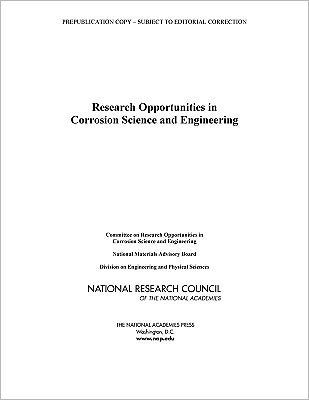Despite considerable progress in the integration of materials by design into engineering development of products, corrosion considerations are typically missing from such constructs. Similarly, condition monitoring and remaining life prediction (prognosis) do not at present incorporate corrosion factors. Great opportunities exist to use the framework of these materials design and engineering tools to stimulate corrosion research and development to achieve quantitative life prediction, to incorporate state-of-the-art sensing approaches into experimentation and materials architectures, and to introduce environmental degradation factors into these capabilities.
Research Opportunities in Corrosion Science and Engineering identifies grand challenges for the corrosion research community, highlights research opportunities in corrosion science and engineering, and posits a national strategy for corrosion research. It is a logical and necessary complement to the recently published book, Assessment of Corrosion Education, which emphasized that technical education must be supported by academic, industrial, and government research. Although the present report focuses on the government role, this emphasis does not diminish the role of industry or academia.
Despite considerable progress in the integration of materials by design into engineering development of products, corrosion considerations are typically missing from such constructs. Similarly, condition monitoring and remaining life prediction (prognosis) do not at present incorporate corrosion factors. Great opportunities exist to use the framework of these materials design and engineering tools to stimulate corrosion research and development to achieve quantitative life prediction, to incorporate state-of-the-art sensing approaches into experimentation and materials architectures, and to introduce environmental degradation factors into these capabilities.
Research Opportunities in Corrosion Science and Engineering identifies grand challenges for the corrosion research community, highlights research opportunities in corrosion science and engineering, and posits a national strategy for corrosion research. It is a logical and necessary complement to the recently published book, Assessment of Corrosion Education, which emphasized that technical education must be supported by academic, industrial, and government research. Although the present report focuses on the government role, this emphasis does not diminish the role of industry or academia.

Research Opportunities in Corrosion Science and Engineering
192
Research Opportunities in Corrosion Science and Engineering
192Paperback

Product Details
| ISBN-13: | 9780309162869 |
|---|---|
| Publisher: | National Academies Press |
| Publication date: | 02/27/2011 |
| Pages: | 192 |
| Product dimensions: | 7.00(w) x 9.90(h) x 0.50(d) |
